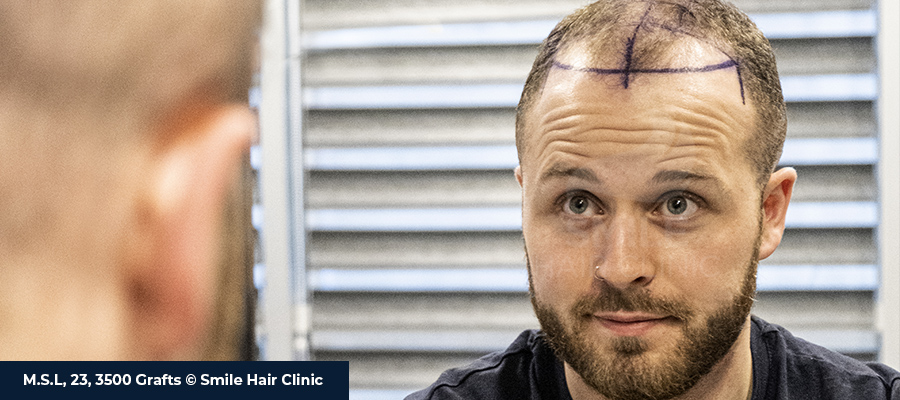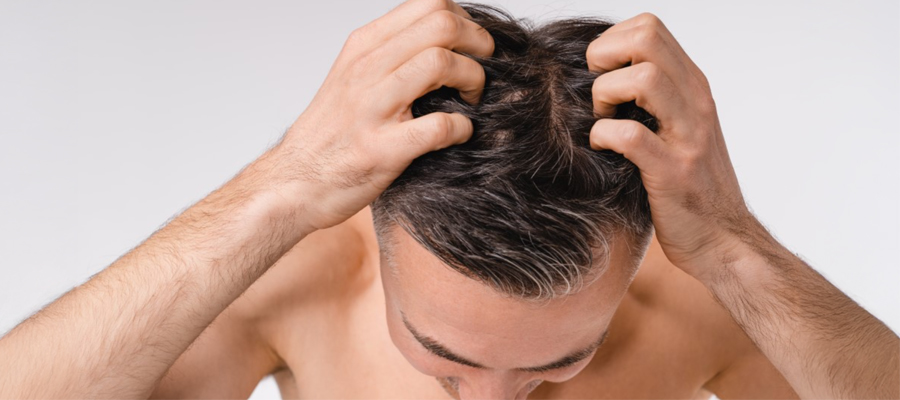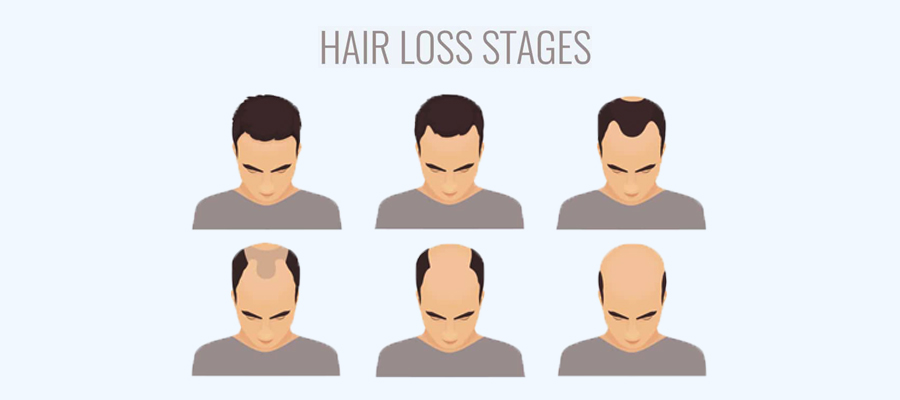Hair Loss in Men

Hair Loss in Men
Men begin to bald in their late 20s. It becomes especially noticeable after 50 years.
There are many causes of male hair loss, including hair washing, skin diseases, infections, malnutrition and the use of various drugs. These factors have a reason, but the main reason is heredity – or, rather, androgynous. The male hormone testosterone triggers genetic hair loss. The said hormone, in contact with 5-alpha-reductase, turns into dihydrotestosterone, the action of which eventually leads tufted hair to thin and empty.
The genetic hair loss that males experience is officially called “androgenetic alopecia” known as AGA. The following are some known facts about current medicine: “At present, many genes are implicated in the pathogenesis of AGA. Eight suspicious areas on the X chromosome related to male hair loss, including the part encoded by the androgen receptor gene, have been reported.
Recent studies have suggested that, surprisingly, early-onset AGA and some major diseases may have genetic links. However, these links have not yet been fully proven. In addition, research has indicated that increases in Prostaglandin D2 levels are responsible for AGA-style hair loss.
What is male-pattern hair loss or loss of male type?
Androgenetic Alopecia (AGA) is the most common cause of hair loss in men. It is also known as male alopecia, male-pattern hair loss, or male-type hair loss. Hair loss occurs when the most potent androgen hormone, testosterone, is converted into dihydrotestosterone (DHT) by a 5-alpha-reductase enzyme in the hair follicle. Usually, hair loss starts on both sides of the head bitemporal and continues to below via a middle front line.
Miniaturization
Miniaturization means shrinking hair follicles over time; the roots become finer and thinner, so they easily fall out. As this process continues over time, hair loss becomes visible, and this spread leads to baldness in particular areas of the head.
How Miniaturization Occurs
Hair follicles naturally pass through a growth cycle of three stages:
An agen (growth phase): The growing stage where new hair production occurs from the hair follicle.
In this phase, the hair growth slows down, and the hair follicle shrinks.
Telogen (resting phase): This is a shedding of hair and follicle rests to prepare for the cycle to start again.
An active growth phase in a healthy follicle can last several years, producing long, thick hair. But in the smaller miniaturized version, plant growth is hampered. With continued expansion, the anagen phase decreases in duration, and the length of the catagen and telogen phases increases. This causes the hair follicle to spend less time growing new hair and a longer time at rest and shedding.

In this miniaturization process, hair shifts from thick, healthy to finer hair, and the hair density on the scalp seems lower. In the final stages, only bais left. Without treatment, the loss of hair will be permanent.
Hair fall and baldness are very painful things that people suffer because these things break all social life for the person. The constant fear of being ridiculed, ignored or put down simply because of the way one’s hair looks leads to stress, so this could be the reason to push people in the Golden Age to go into depression as well. Patients often report losing confidence in themselves. After hair transplant procedures, our doctors frequently hear expressions similar to “I have regained my self-confidence.” Or “Thank you for giving my life back.”
More than half of all men aged over 50 suffer from androgenetic alopecia hair loss.
A simple medical examination can help diagnose hair loss. Proper treatment and care can help halt, slow, or completely limit the hair loss process.
The Norwood Scale for Stageging Hair Loss in Men
Male Pattern Baldness Stages—Norwood Classification The table below shows the average number of grafts used for the three Norwood scale patterns.
Patients with advanced (Norwood Type 5, 6, or 7) hair fall patterns typically require the two-session FUE hair transplant method, as complete hair loss can not be covered in one go.

Here are some Hair Loss Treatments For Men:
Finasteride
Male-pattern hair loss is predominantly genetic and is caused by a condition called androgenetic alopecia (AGA). Drugs containing Finasteride prevent dihydrotestosterone (DHT) production by blocking the action of the 5-alpha-reductase enzyme.
Blocking the formation of DHT helps to reduce hair thinning and loss (male pattern baldness/male-type hair loss).
Finasteride Treatment is always advised for male patients with Sapphire Hair Transplantation and/or experiencing hair loss at Smile Hair Clinic. Our patients’ follow-ups in one year and two years, which were conducted by our doctors, have demonstrated the substantial impact of finasteride quality in patients.
There are tons of myths online on the side effects of finasteride. There is no compelling evidence in scientific literature to suggest finasteride. There has been a lot of online discussion regarding the types of side effects. For the ones who are afraid of the side effects of Finasteride, prescribe “Topical Finasteride” since it has the same effectiveness as pills and its plasma concentrations reach ¼ of the pill, so the risk of side effects is minimal. People can order Topical Finasteride online in the U.S.A. and U.K.
Please keep in mind that Finasteride is an FDA-approved treatment for hair loss, and it is currently the gold standard for hair loss treatment.
Minoxidil
Minoxidil is a vasodilator—that is, it widens blood vessels. Though we still do not know the exact mechanism of action for hair growth, Minoxidil is believed to enhance oxygen and nutrient delivery to the hair follicles due to increased blood circulation. This increased blood supply prolongs the hair cycle’s anagen (growth) phase and revives dormant follicles, a common occurrence in conditions such as androgenetic alopecia.
Minoxidil affects primarily the scalp (and not necessarily the rest of your body) by:
Grow the Depth Of Your Hair Follicle: Minoxidil creates normal-size hair follicles, which in turn create larger, stronger hair.
Lengthen the Anagen Phase—By extending the anagen phase, your hair is now able to grow for longer periods of time.
Awaken Dormant Follicles: Minoxidil can sometimes rinse dormant follicles (near bald ones) and kick them up the rear.
Who Can Use Minoxidil?
Minoxidil is most often used for:
Androgenetic Alopecia (Pattern Hair Loss) is the most common hair loss affecting both men and women. In men, this is typically a receding hairline and balding on the crown, with women often having diffuse thinning over the top of the scalp.
This is a common type known as Telogen Efflux, which is temporary and usually caused by acute stress, rapid weight loss, major surgery, or illness.
Alopecia Areata: An autoimmune condition that causes balding in circles.
Other Non-Scarring Hair Loss Conditions: Some people with other forms of non-scarring alopecia in which hair follicles can still grow may also find Minoxidil helpful.
FUE Hair Transplantation
The most effective remedy for those of you in the unfortunate position of losing hair is Sapphire FUE Hair Transplantation. Using the expertise of experienced surgeons, FUE hair transplant surgeries can restore people to nearly their normal look and, in some cases, go back as far as several decades.
While sapphire hair transplantation may seem like an easy process for many, it is a major surgery that requires a high degree of knowledge and ability. Tailored treatment plans need to be created and meticulously followed for good outcomes.
If you would like to learn more about choosing a clinic for Sapphire FUE Hair transplant, that covers all aspects carefully before deciding which clinic or doctor is best suitable for this surgery.
For more information regarding the best treatment options for your hair loss, contact us at Smile Hair Clinic so that our medical experts can assist you and provide you with it.
 Whatsapp
Whatsapp
